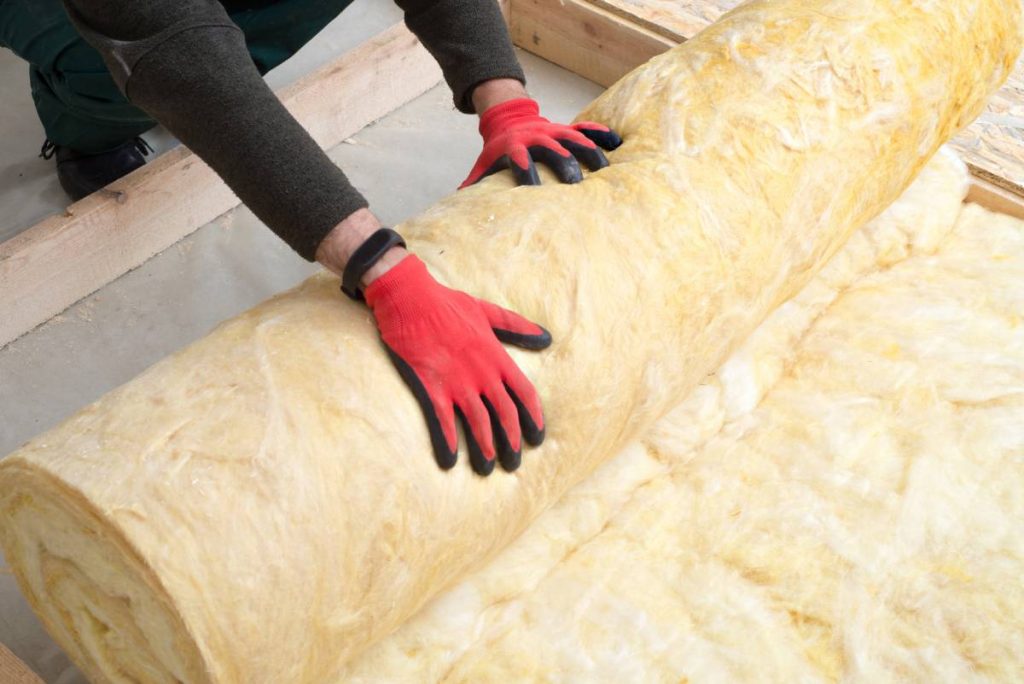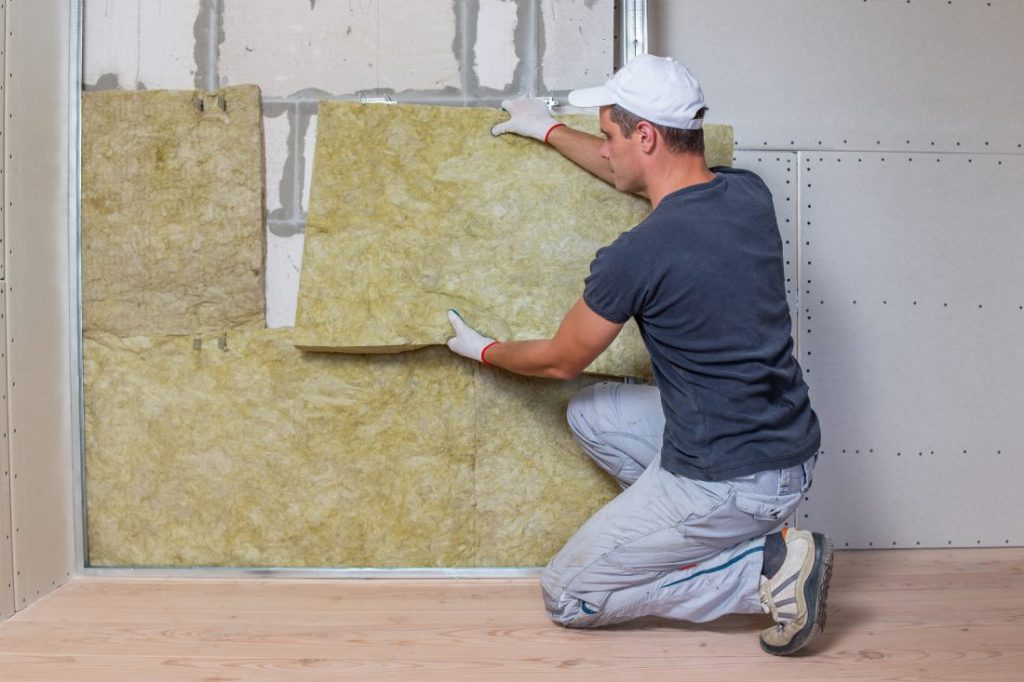Table of Contents

What kind of mineral wool should be used to insulate balconies walls, ceilings, floors or roofs? You will find the answer to this question below. In the article we will talk about the properties of different materials and offer brief schemes for thermal insulation of a private house or apartment with mineral wool.
Mineral Wool Insulation requirements
- Water vapor permeability from 0.3 mg / (m · h · Pa) . Due to this property, the material allows moist air to pass through. If the vapor permeability of the insulation is low, moisture will concentrate inside the room. Because of this, a fungus forms in the house, and the walls are destroyed.
- Resistance to deformation. High stability is achieved due to the special structure. The fibers that make up the mineral wool should be placed randomly. If they lie in the same direction, shrinkage and delamination threaten the insulation.
- Refractoriness. For whatever the mineral wool is used, it must be non-flammable. Lack of this property will lead to rapid flame spread during a fire.
- Environmental friendliness. Poor insulation can release substances harmful to humans. If you are looking for a material for insulating residential buildings, pay special attention to the environmental friendliness of the insulating layer.
Types of mineral wool
Basalt mineral wool
Insulation, which is produced from igneous rocks, is reliable, easy to use and safe for humans. This compares favorably with other varieties of mineral wool .
- Thermal conductivity – 0.032-0.048 W / (m · K)
- Density – 15-220 kg / m³
- Water absorption – 0.95%
- Water vapor permeability – 0.4-0.6 m · h · Pa
- Non-toxic material
- Non-flammable material
Glass wool
The second most popular type of mineral wool. It is noticeably inferior to the first in safety and other technical characteristics. This material is made from the same raw materials as glass (quartz sand, soda and lime).
- Thermal conductivity – 0.038-0.046 W / (m · K)
- Density – 10-130 kg / m³
- Water absorption – 1.7%
- Water vapor permeability – 0.4-0.5 m · h · Pa
- Non-toxic material
- Non-flammable material
Slag wool
Mineral wool from blast-furnace slag – a waste of metallurgical production – is already a thing of the past. The demand for it is small, since the slag wool contains phenol-formaldehyde resins that are hazardous to health. Nowadays, it is used only for external insulation of temporary buildings.
- Thermal conductivity – 0.46-0.48 W / (m · K)
- Density – 10-125 kg / m³
- Water absorption – 1.9%
- Water vapor permeability – 0.3-0.6 m · h · Pa
- Toxic material
- Non-flammable material
Rockwool Insulation-What It Is and Where to Use It
The importance of a well-insulated home can’t be overstated: Properly sized and installed insulation can reduce energy usage, keep you warmer in winter and cooler in summer, and save you money with lower energy bills.
For homeowners and homebuilders alike, fiberglass insulation has been the insulation of choice for many decades. While fiberglass remains very popular, there’s a relatively new type of insulation that’s making headway—and headlines—in the insulation industry. It’s called rock-wool insulation.
What Is Rock Wool Insulation?
Rock wool, which is also called mineral wool, comes in easy-to-install batts, similar to fiberglass. But instead of being composed of fluffy glass fibers, rock wool is made of—you guessed it—rocks, which doesn’t even seem possible. Here’s a brief explanation of the manufacturing process.
Natural rock is heated in a furnace to about 3,000 degrees until it melts into a liquid. The magma-like liquid is exposed to a high-pressure jet of air or steam, and then spun at super-high speed into long fiber strands. (Think: cotton candy machine filled with liquid rock.) The strands are captured and compressed into thick, dense mats, which are then cut into convenient-sized batts of insulation.
The unique composition of rock wool produces a high-performing insulation with the following features:
- Made from natural, sustainable material
- Typically contains up to 75 percent recycled content
- Retains heat well and traps air, which slows the transfer of heat
- Non-combustible and fire resistant to about 1,400 degrees
- Highly water repellent
- Excellent sound-deadening properties
- Higher insulating value than fiberglass
- Long-term performance—rock wool doesn’t degrade over time
- Allows moisture to escape (which deters mold and mildew)
- Dense, firm batts are friction-fit into place; no stapling necessary
Where to Use Rock Wool Insulation
Rock-wool insulation can be installed wherever you’d install fiberglass or any other type of insulation, including walls, floors, ceilings, attics and crawlspaces. However, it’s particularly well-suited for rooms along the cold north side of the house and for interior rooms in need of sound deadening, such as media rooms or music studios.
Because rock wool is highly fire resistant, it’s ideal—and often code-required—for use as a firestop between floors of a house. (During remodeling or new construction, ask the local building inspector to identify specific areas that require rock wool firestops.)
Rock wool is also easy to work with: The firm batts can be cut with a serrated knife or handsaw to fit snugly into place. If it gets wet, water beads up and rolls off without soaking into the fibers. The rock-wool fibers are compacted so tightly together that there’s no chance of the insulation shifting out of position or slumping down, which would dramatically decrease its insulating value.
Note that rock-wool insulation only comes un-faced, meaning there’s no kraft-paper or foil barrier. Depending on the situation, you may need to install an independent permeable membrane to serve as a vapor barrier.
What is insulated with mineral wool and why

Can mineral wool be used to insulate the walls of a wooden or frame house, insulate the facade, roof, floor or ceiling? Of course, you can, if you approach its selection and installation with due attention.
What mineral wool is better for insulating a house with your own hands from the outside or from the inside? It all depends on the specific task, but in most cases, basalt mineral wool will be the right choice.
Insulation of the facade
What kind of mineral wool to choose for wall insulation outside?
Basalt-based material is suitable for insulating houses with mineral wool outside. Do not be afraid to use this mineral wool for insulating frame walls, aerated concrete and wooden structures. It has the least hygroscopicity, which means it will not absorb moisture that gets on the facade during precipitation.
The thickness of the facade insulation with mineral wool ranges from 5 to 20 cm, depending on climatic conditions. The required density of mineral wool for thermal insulation is 50–110 kg / m³ (for insulation of ventilation facades) or 130–150 kg / m³ (for insulation with mineral wool under plaster).
Mineral wool insulation technology
- “Wet” facade. The insulation is glued to the bearing wall and covered with reinforcing and decorative layers. This technology is considered optimal, since the multi-layer structure of the facade protects the base and insulation from the external environment.
- “Dry” facade. The insulation is attached to the brackets. The slabs are covered with a windproof membrane, siding or tiles are placed on top. “Dry” technology is easy to install, but has a significant disadvantage – fire hazard. The fact is that the design of ventilated facades creates ascending air currents that rise along the wall. Because of them, localized fire can quickly spread over a large area. This is another reason to purchase mineral wool for insulating a house for siding – a non-combustible material.
Mineral Wool Insulation of internal walls and ceiling
The best mineral wool for insulation from the inside of walls and ceiling

The best solution for thermal insulation of the ceiling and walls inside the house with mineral wool will again be material from rocks. It is environmentally friendly, passes steam well, does not burn, does not attract rodents and does not become a breeding ground for living organisms.
Do not use mineral wool from imperfect materials to insulate the walls of the house from the inside. Remember that slag wool is toxic and fiberglass consists of extremely fragile and prickly particles that can be airborne with dust. Getting on the mucous membranes, they cause irritation and allergic reactions.
Also Read: How much paint does it take to paint the walls?
Not sure what thickness or density of mineral wool is required for internal insulation? Focus on the following indicators: thickness – 2-10 cm, density – 15-20 kg / m³. A material whose characteristics are closer to the upper boundaries is optimal for thermal insulation of a balcony or loggia with mineral wool.
walls and ceiling Mineral wool insulation technology
Internal isolation is not often used: this method “eats up” free space and does not cope with its tasks so effectively. However, if for some reason you decide to insulate from the inside, you can glue cotton wool or fix it on the crate, and then cover it with sheets of drywall.
Floor insulation
What mineral wool is better to insulate the floor?
The best mineral wool for insulating wooden or concrete floors is basalt. For insulation under a concrete screed, it is worth using only the densest cotton wool (175-200 kg / m³). For a wooden floor, the figure may be lower: 150–160 kg / m³. The recommended thickness of floor insulation with mineral wool is 10–30 cm.
Floor Mineral wool insulation technology
- Thermal insulation along the logs. This is a simple, quick and quite effective method, which is most suitable for insulating floors in a wooden house with mineral wool. In this case, first, a frame of beams is mounted, a heater is placed between its elements, it is covered with hydro and vapor barrier, and a finished floor is laid on top.
- Insulation of the concrete floor. Such floors are a more durable solution. They will be appropriate in rooms with strong mechanical stress (for example, in a garage), or as a base for tiles. Please note that concrete absorbs moisture well, so you have to take care of additional waterproofing. It is put in two layers – under the insulation and on top of it, after which the vapor barrier is lined and only after that the solution is poured.
Roof insulation
Which mineral wool is best for the roof?
Mineral wool is suitable for both external and internal roof insulation. In this case, it is worth making a choice in favor of basalt or fiberglass insulation. Consider the weight of the material: mineral wool for roof insulation must be dense (at least 55 kg / m³), but not too heavy, so as not to overload the structure. The layer thickness is also important – about 15 cm.
Roof Mineral wool insulation technology
- External insulation. This method is considered the best: it retains more heat and protects the main structure from the external environment. External insulation can only be done during the construction phase. To do this, you need to install a solid plywood base on the rafters, lay a vapor barrier in the second step, then insulation, waterproofing, ventilation crate, counter battens and a roof.
- Internal insulation. It is carried out as an additional measure after the completion of construction work. The rafters are laid with waterproofing, and then with the insulation itself. If the thickness of the material exceeds the thickness of the rafters, wooden slats are placed across the structure. The installation is completed with a layer of vapor barrier and finishing plating of the “pie”.
What to look for when choosing Mineral Wool?
- Tightness. The original packaging must not be opened. This is a guarantee that the material does not lose quality during transportation and storage.
- Storage conditions. If the packaging is made of moisture-permeable material (such as cardboard), assess the humidity level in the room where the insulation is stored. It should not exceed 60%.
- Manufacturer reliability. Trust the industry leaders: ROCKWOOL, KNAUF, Ecoroll and ISOBOX. According to buyers, the best mineral wool for insulating a house outside and inside is produced by them.
